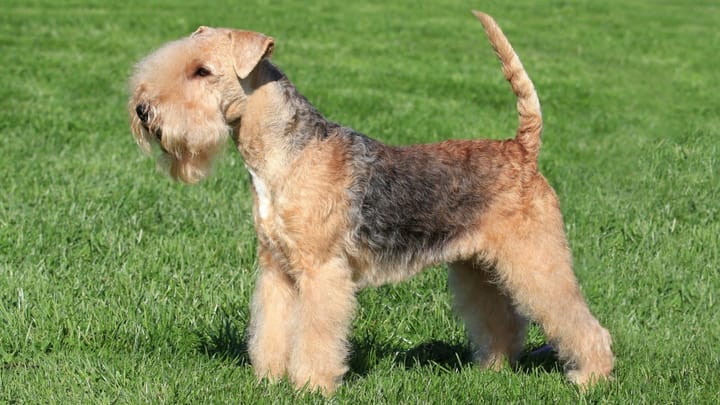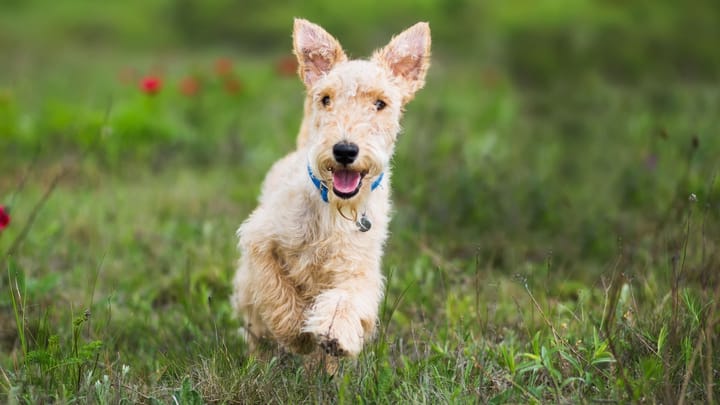Lakeland Terrier
Other name: Lakeland


The Lakeland Terrier is very lively, courageous, fiery, and loyal to his owner (although independent). But he can be rather hostile towards strangers and other dogs. The Lakeland Terrier is perfect for the work he was bred for: he is very agile and determined, he is able to jump from rock to rock even without momentum, he can confront and kill prey that’s bigger and stronger than him. However, his fiery temperament results in occasional fights with his peers.
|
Life expectancy |
The Lakeland Terrier has a life expectancy of between 13 and 15 years |
|
Temperament |
|
|
Size |
Medium
|
|
Adult size |
Female
Between 13 and 15 in
Male
Between 14 and 15 in
|
|
Adult weight |
Female
Between 13 and 18 lb
Male
Between 15 and 20 lb
|
|
Coat colour
The coat can be single-coloured (red, wheaten, red grizzle, liver, blue or black) or bi-coloured (black and tan, or blue and tan). |
Black Brown Red Blue |
|
Type of coat
The fur is short. The fur is dense with a rough texture and a good undercoat. |
Short |
|
Eye colour
The eyes are dark or hazel-coloured. |
Brown
|
|
Purchase price |
The Lakeland Terrier costs between £360 and £680 |
In the 19th century, dogs that had the same origin as the Lakeland (lake area) came in different types and had various names such as Patterdale Terrier, Fell Terrier or even Working Terrier. All of these dogs were unified under the name Lakeland Terrier in 1912, to standardize the breed we know today.
More details about the Lakeland Terrier
Lakeland Terrier: Origins and history
This breed owes its name to the strait formed by the Lakes of the north-western English coast. In this region, the breed developed mainly out of necessity and not for sporting reasons as was the case with most Terriers. In fact, the Lakes region was populated by foxes with a higher-than-average size, who devoured chickens, rabbits, and deer. Fox-hunting was impossible in these inaccessible lands and it was therefore necessary to breed dogs for the hunt: these were the Lakeland Terrier’s ancestors. Several Terriers have participated in the creation of the breed we know today: The Bedlington Terrier, the Dandie Dinmont Terrier, the Border Terrier, the Fox Terrier and the Airedale Terrier. The first standard of the Lakeland was written in 1912 and the English Kennel Club recognised the breed in 1921. It was only in 1954 that the CFI officially recognised the breed.
Physical characteristics of the Lakeland Terrier
The Lakeland Terrier is a bright, work-fit, balanced and compact dog. The head has a flat, refined skull, powerful jaws and a wide snout. The eyes are dark or hazel. The ears are small and "V" shaped; these are always twitching with cheerfulness. The neck has a good length, and is slightly arched. The body is slightly narrow, the back is short and elevated. The limbs are muscular and perfectly level. The tail moves joyfully, and never curls or moves over the back.
Lakeland Terrier: Characteristics
Lakeland Terrier: Behaviour
Training a Lakeland Terrier
Obstinate in nature, it is sometimes difficult to make the Lakeland Terrier cooperate because he is far from docile or submissive.
Thus, a firm, coherent, early and attentive education is necessary to achieve a satisfactory relationship with this dog.
Although he likes to delight his master, his strong temperament and his cunning instincts sometimes make him forget what the rules are. It is therefore necessary to never surrender anything to him and to offer regular treats when training.
Lakeland Terrier: Lifestyle
Breed compatibility Lakeland Terrier
Lakeland Terrier: Purchase price
The price of a Lakeland Terrier varies depending on its origins, age and gender. It is important to find a quality breeder that can prove the purity of the lineage and the proper selection of his parents, so as to avoid any genetic problems. You have to estimate an average of £680 for a dog that is part of the Kennel Club.
Regarding the average budget to support a dog of this size, it takes about £20/month, excluding grooming costs - which can be frequent and sometimes expensive.
Lakeland Terrier: Shedding
Average
Hair loss is moderate, especially if the coat is regularly brushed. This dog does not suffer from excessive annual shedding.
Lakeland Terrier: Grooming
This dog, although rustic by nature, needs regular and specific grooming. The Lakeland needs a complete makeover, including hair removal and trimming, at least once a trimester.
At the same time, weekly brushing is necessary to maintain the beauty, cleanliness, and protective qualities of the coat.
Dogs that often go into the water should be dried thoroughly after each swim.
Since the eyes are sensitive, make sure to clean them regularly.
Lakeland Terrier: Health
The Lakeland’s lifespan is estimated at 14 years.
The Lakeland Terrier is very sturdy and durable. He lives for very long time and is generally very healthy.
If yours is a working dog, you should avoid exploiting him too much when it's hot. He is so determined and obstinate that he could drive himself to exhaustion, because he doesn’t know when to stop.
His coat gives him perfect protection against bad weather, allowing him to live outside.
His dynamism allows him to burn off excess calories quickly, so he is not generally affected by weight problems.
- Eye diseases (glaucoma, cataracts)
- Dermatological problems (allergies)
- Legg-Calvé-Perthes disease
- Hypothyroidism



